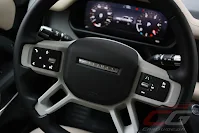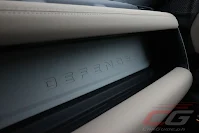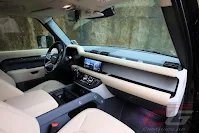Reinventing an automotive icon like the Land Rover Defender isn’t easy. It involves taking special care to pay respects to the original without producing something overly cliched, or even worse, a caricature. It’s something Land Rover thought long and hard before reviving the Defender name, and even then, it had to overcome a deafening roar of opinion, both negative and positive. On one hand, there are people who praised the design and the progressive engineering; on the other, trolling from those who said it’s too posh.
In the end, Land Rover decided that the right approach was to leave no room for criticism, so they made it more practical, more refined, and yes, more capable than the original. It won’t certainly please the trolls—in this case, the “I’m not a fan of fancy electronics” OG Defender fan—but for everyone else, be it a hardcore off-road enthusiast, or urban hipster, the new Defender is a downright winner.
With a choice of two body styles—the shorter Defender 90 with three doors, and the longer Defender 110 with five doors—this Land Rover finds itself having to compete with a wide spread of rival SUVs. For the D90, it’s aimed more towards the likes of the Jeep Wrangler or Mercedes-Benz G-Glass. Price-wise though, at P 5.690-million, it sits nicely between these two, balancing value and luxury very well.
The exterior design is a masterstroke for Land Rover. With a width of 2,105 mm and a height of 1,974 mm (without accessories)—the D90 is basically a box with wheels; perfect to communicate its intentions as a hardcore SUV. Moreover, it ekes out interior room, while improving all-around visibility (because it’s easy to see where the bodywork begins and ends). It also happens to evoke the old Defender in stride, yet is thoroughly modern with subtly curved (not flat-sided) body panels. Perhaps the only criticism one could lob at it would be that the Explorer Pack is a tad over the top—especially the side-mounted gear carrier which compromises the driver’s three-quarters rear visibility. Heed this advice: save the P 300,000 and opt for the Urban Pack instead.
Despite having just three doors, the Defender 90 is roomy. Again, those boxy proportions are put to good use giving everyone on board lots of space in every direction. Getting in (or out) requires strong knees and legs, but once inside, the driver is rewarded with a lofty view—higher than any “soft roader” or even some more conventional body-on-frame SUV (PPVs come to mind).
The dashboard has taken an industrial approach, and it’s worked beautifully here. Some structural elements are deliberately exposed including the front crossbeam that functions as part of the dashboard and also as grab handles. There are lots of exposed bolt heads dotting the interior too, emphasizing the Defender’s characteristically utilitarian feel, and most of the surfaces are covered in a rugged-feeling rubberized material.
Crucially, despite the Defender’s fit for purpose design, it outclasses most of its road-focused rivals. Land Rover’s play on colors and material make it, for the most part, feel reassuringly expensive. There are bits that don’t feel as slick such as the light/wiper stalks and the windows switches, but apart from that it’s like a chunky, rugged-looking yet well-crafted Swiss diving watch.
In front of the large diameter steering wheel is a set of completely digital instrument dials, configurable to display information in a variety of ways. At the center, is a 10-inch touchscreen loaded with Land Rover’s latest infotainment system. There’s lots of functionality, including Apple CarPlay and Android Auto baked in, and because the menus aren’t as littered with countless sub-menus, navigating through them is a cinch. But while the screen is crystal clear and the graphics are impressive, it doesn’t feel as snappy due to excessive use of on-screen animations.
As with any three-door, five-seater vehicle (SUV or otherwise), accessing the rear seats can get awkward. The lever to tip the seats is located at the top of the seatback which is fine for adults, but can be a challenge for children (or the vertically challenged). Plus, once the seat moves back into place, it doesn’t remember its original position, sadly.
In terms of cargo space, the D90’s hold is quite small. In terms of volume, it’s not so bad—at 297 liters, it’s about the same as some compact hatchbacks. In practice, that space is more vertical. It’s alright if stacking items on top of each other is a-okay, but there’s not much room between the tailgate and backseats. Collapse the rear seats though (it folds down in a 40/20/40 split), and the luggage capacity goes up to 1,263 liters.
The Defender’s CV may be focused around its off-road prowess, but it doesn’t drive down the road like one. And that’s a great thing. There’s absolutely no unruliness, vagueness, or queasiness. The axles don’t shudder and the body doesn’t shake. Everything feels tied together.
Gifted with a long suspension travel, the D90’s soft and gentle in its reaction—far removed from the forced urgency of “sporty” SUVs. It really is real-world sensible, absorbing hard shocks and shudders from corrugated surfaces. Provided steering inputs are delivered smoothly, pitch and roll are well-managed. Even without air suspension (the three door rides on standard coil springs), it can still be whisked along a difficult road at a respectable speed and remarkable comfort.
Thanks to the Defender’s boxy proportions and high driving position—and despite its substantial girth—it’s easy to judge the outer extremities be it through car parks, or EDSA’s narrow lanes. The rear-door-mounted spare tire does make it tricky to see out the back so thankfully front and rear parking sensors, plus a 360-degree camera is standard. It also has a camera-based rear-view mirror too. Called Clear Sight, flipping the mirror turns it into a digital screen that shows a live camera feed from directly behind the car. It’s great when three adults find themselves in the back seat, or if the cargo hold is loaded to the roof.
While prowess on the rough stuff can’t be tested on this occasion (the test drive agreement strictly forbids it), the Defender’s ability to carry on when the going gets tough is legendary. And on the new Defender, it’s much easier thanks to its Terrain Response system.
Fitted with a 2.0-liter twin-turbo diesel, the Defender 90 comes with 240 horsepower (hence the D240 designation) and 430 Nm of torque. On paper, this doesn’t sound like a lot, but it’s more than enough. Off the line, it feels reasonably torquey, especially considering that there’s 2,231-kilograms of curb weight to pull. Land Rover says the century mark comes in 9 seconds flat, but that’s not the point. Instead, it’s all about effortless motoring with power that’s readily available at the request of the right foot, be it on the highway or on the trails. It’s also remarkably efficient, registering 7.93 km/L, and mighty refined with nary an unwanted sound or vibration.
Very few buyers will make full use of the Land Rover Defender’s capabilities. For those that won’t, they’ll still find it a family-friendly SUV with great on-road manners. But when drivers do need to tap into its breadth of off-road ability—be it to plow through floods, or tackle an unplanned trail—like that truck lane on C5—it’s immensely reassuring. Overall, it’s amazing how it feels dignified and always ready for adventure at the same time. And for that, the new Defender is effectively in a class of one.
|
2021 Land Rover Defender 90 S D240 Explorer Pack |
|
| Ownership | 2021 Land Rover Defender 90 S D240 Explorer Pack |
| Year Introduced | 2021 |
| Vehicle Classification | Luxury SUV |
| Warranty | 3 years / 100,000 kilometers |
| The Basics | |
| Body Type | 3-door SUV |
| Seating | 5 |
| Engine / Drive | F/AWD, Low |
| Under the Hood | |
| Displacement (liters) | 2.0 |
| Aspiration | Twin Turbo |
| Fuel Delivery | Common Rail |
| Layout / # of Cylinders | I4 |
| BHP @ rpm | 240 @ 4,000 |
| Nm @ rpm | 430 @ 1,400-3,750 |
| Fuel / Min. Octane | Diesel |
| Transmission | 8AT |
| Cruise Control | Yes, w/ Limiter |
| Fuel Economy @ Ave. Speed | 7.93 km/L @ 18 km/h |
| Dimensions and Weights | |
| Length (mm) | 4,583 |
| Width (mm) | 2,105 |
| Height (mm) | 1,974 |
| Wheelbase (mm) | 2,587 |
| Curb Weight (kg) | 2,231 |
| Suspension and Tires | |
| Front Suspension | Independent, Double Wishbone |
| Rear Suspension | Independent, Integral Link |
| Front Brakes | Vented Disc |
| Rear Brakes | Vented Disc |
| Parking Brake | Electric, w/ Auto Hold |
| Tires | Pirelli PZero MO 275/45 R 21 Y (f & r) |
| Wheels | Alloy |
| Safety Features | |
| Airbags | 6 |
| Anti-Lock Brakes (ABS) | Yes, with EBD |
| Traction / Stability Control | Yes |
| Parking Sensors | Yes, Front & Rear |
| Parking Camera | Yes, 360-degree |
| Front Seatbelts | 3-pt ELR with pre-tensioner x 2 |
| Rear Seatbelts | 3-pt ELR x 3 |
| ISOFIX Child Seat Anchor | Yes |
| Other Safety Features |
Hill Start Assist Hill Descent Control Tire Pressure Monitoring Driver Condition Monitor Lane Keep Assist |
| Exterior Features | |
| Headlights | LED |
| Fog Lamps | Yes, Front & Rear (LED) |
| Auto Lights | Yes |
| Rain-sensing Wipers | Yes |
| Tailgate | Manual |
| Interior Features | |
| Steering Wheel Adjust | Tilt/Telescopic |
| Steering Wheel Material | Leather |
| Seating Adjustment (driver) | Partial Electric, 12-way |
| Seating Adjustment (front passenger) | Partial Electric, 12-way |
| Seating Surface | Leather |
| Folding Rear Seat | Yes, 40/20/40 |
| Sunroof | No |
| Trip Computer | Yes |
| Convenience Features | |
| Power Steering | Yes |
| Power Door Locks | Yes |
| Power Windows | Yes |
| Power Mirrors | Yes, w/ Fold |
| Rear View Mirror | Auto Dimming, w/ Camera |
| Proximity Key | Yes |
| Climate Control | Auto, Dual Zone, w/ Rear Vents |
| Audio System |
Stereo USB Type A USB Type C Bluetooth GPS |
| Smartphone Connectivity |
Apple CarPlay Android Auto |
| # of Speakers | 6 |
| Steering Controls | Yes |






























Isnt 8km/L bad? thats like 13L/100km, or is it good because we're talking land rover here? thanks for the answer
ReplyDeleteFor those speeds (18 km/h) and an engine that's not broken in? That's pretty reasonable. By comparison, the Everest 4WD and Fortuner 4WD both do worse.
Deletethanks
Delete